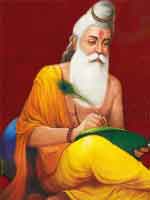Religious Mentors
Truth is the highest Dharma.

Valmiki (Sanskrit: वाल्मीकि) is celebrated as the harbinger-poet in Sanskrit literature. He is the author of the epic Ramayana, based on the attribution in the text of the epic itself. He is revered as the adi Kavi, which translates to First Poet, for he invented Sloka (i.e. first verse or epic metre), which set the base and defined the form to Sanskrit poetry.
Early life
The Uttara Kanda tells the story of Valmiki's early life, as a highway robber named Ratnakar, who used to rob people after killing them. Once, the robber tried to rob the divine sage Narada for the benefit of his family. Narada asked him if his family would share the sin he was incurring due to the robbery. The robber replied positively, but Narada told him to confirm this with his family. The robber asked his family, but none agreed to bear the burden of sin. Dejected, the robber finally understood the truth of life and asked for Narada's forgiveness. Narada taught the robber the mantra for salvation. But, the mantra in question, the name of Lord Rama, was not to be given to murderers and the like. Narada thus told Valmiki to chant "Mara" the phonetic anagram of "Rama" instead to circumvent this restriction. The robber meditated for many years, so much so that ant-hills grew around his body. Finally, a divine voice declared his penance successful, bestowing him with the name "Valmiki": "one born out of ant-hills" (Valmikam in Sanskrit means Ant-hill).
Writer of the Ramayana
The Ramayana, originally written by Valmiki, consists of 23,000 Slokas and 7 cantos including the Uttara canto. Ramayana is composed of about 480,002 words, being a quarter of the length of the full text of the Mahabharata or about four times the length of the Iliad. The Ramayana tells the story of a prince, Rama of Ayodhya, whose wife Sita is abducted by the demon-king (Rakshasa) of Lanka, Ravana. The Valmiki's Ramayana is dated variously from 500 BC to 100 BC, or about co-eval with early versions of the Mahabharata. As with many traditional epics, it has gone through a process of interpolations and redactions, making it impossible to date accurately.
Valmiki is also quoted to be the contemporary of Sri Rama. Sri Rama met Valmiki during his period of exile and interacted with him. Valmiki gave shelter to Sita in his hermitage when Rama banished her. KuSa and Lava the twin sons of Sri Rama were born to Sita in this hermitage. Valmiki taught Ramayana to KuSa and Lava, who later sang the divine story in Ayodhya during the ASvamedha yajna congregation, to the pleasure of the audience, whereupon, King Sri Rama questioned who they were and later visited Valmiki's hermitage to confirm if the Sita, the two children claimed as their mother was in fact his wife in exile. Later, he summoned them to his royal palace. KuSa and Lava sang the story of Sri Rama there, and Sri Rama confirmed that whatever had been sung by these two children was entirely true.
Balmiki community
The Balmiki community found in Punjab, Rajasthan, and Gujarat worship Valmiki as their ancestor and as God.
